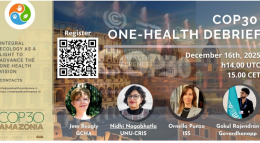UN Member States have said that the 2030 Agenda for Sustainable Development—the historic agreement to end poverty and promote shared economic prosperity, social development, and environmental protection—will most effectively be achieved with the aid of well-designed accountability mechanisms and “a robust, voluntary, effective, participatory, transparent and integrated follow-up and review framework … operating at the national, regional and global levels.”
Using accountability mechanisms to support the implementation of the Sustainable Development Goals, or SDGs, will require serious and strategic thinking. Accountability for the SDGs will and should be led by local and national mechanisms. These mechanisms will be driven by citizens, governments, and their own specific relationships. Regional and global accountability mechanisms can, however, act as so-called force multipliers for such national initiatives and will help states and cities achieve the 2030 agenda.
To do so, accountability mechanisms and their advocates must appreciate that the greatest influence will be found in supportive and appreciative mechanisms. There is no room for punitive mechanisms at the global or regional levels. The more that global and regional tools can enhance and complement local and national accountability efforts—by enabling domestic legislative processes or citizen engagement—the greater the potential effect.
Through an examination of five existing accountability mechanisms—the Annual Ministerial Review, or AMR; the Development Cooperation Forum, or DCF; the International Monetary Fund, or IMF, Article IV consultations; the Organisation for Economic Co-operation and Development, or OECD, peer reviews; and the African Peer Review Mechanism, or APRM—this report identifies two primary pathways for developing accountability mechanisms to influence SDG implementation:
-
Harnessing the power of inspiration. Accountability tools should identify champions—countries and cities that demonstrate significant progress toward meeting or have achieved individual goals and targets—and facilitate the sharing of these success stories; support collective action; and use the positive power of reputation. Using political engagement for publicity forms a valuable part of how accountability can inspire better implementation.
-
Evidenced-based learning. Mechanisms should be explicitly geared to deepen an understanding of what works and what does not; help drive adaptation; and deliver policy reforms. High-quality analysis based on robust standards can help decision-makers and reform leaders to better understand possible pathways to success.
In addition, the authors find six general characteristics that accountability mechanisms should possess in order to be effective. These could provide a useful yardstick for measuring proposals that emerge in the future:
-
Clear objectives. Mechanisms should specify what they hope to achieve and how.
-
Form linked to function. The structure of a mechanism should reflect its objectives and be realistic regarding its limitations.
-
Robust incentives. Critical for building effective SDG accountability mechanisms is understanding the need for incentives both to drive change and to encourage substantive participation. Too many mechanisms create too much of a burden for participants and reduce the likelihood of serious engagement. The use of cost-benefit analysis could help in this effort.
-
Better balance between substance and process. Real, nonsanitized engagement is essential. The use of evidence helps makes mechanisms real. The current discussion needs to shift to a greater understanding of the need for substance.
-
Range of stakeholders. The evidence suggests that member states, without civil-society engagement, tend toward nonsubstantive engagement. The inclusive process that gave rise to the SDGs should be mirrored by inclusive mechanisms for accountability.
-
Use of champions to drive learning. The evidence from past mechanisms suggests that the role of champions and success stories may be the most effective pathway to inspire change and influence policy.
The above lessons highlight the importance of high-level inspiration and continued learning in order to deliver effective policy reforms. In light of such lessons, we recommend that member states take the following four steps:
-
Set transitional objectives for the 2016 High-Level Political Forum, or HLPF. This should include identifying explicit objectives for future HLPFs; driving investment aimed at building robust mechanisms; and ensuring that future HLPFs remain flexible. Member states should also articulate their strategic expectations for the United Nations.
-
Focus HLPFs 2017–2020 on providing the building blocks for future success. This can be achieved by leveraging the principles of robust incentives; using evidence and being inclusive; seeking to identify champions; delivering genuine learning that shapes policy; and maintaining political attention, particularly through a successful 2019 HLPF.
-
Devolve as much as possible. Member states should respect the principle of subsidiarity and ensure that responsibilities within accountability mechanisms are as close as possible to the level of the decisions that they seek to influence. Essentially, this means if any question or discussion could happen at a local, regional, subnational, or national level, it should.
-
Be unafraid to be creative. The HLPF offers an opportunity to use tested mechanisms such as prizes. For instances, member states could hold a competition for creative suggestions, with the prize being attendance at the 2019 HLPF. There should also be a move to experiment with youth involvement or perhaps the establishment of a commission on lessons to be learned, which would model bold approaches used by states and cities.
Access Designing Better Accountability Mechanisms for the 2030 Agenda for Sustainable Development here.




